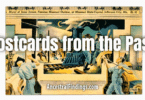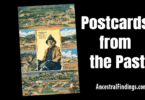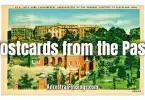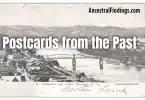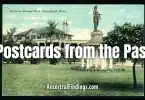There’s something about the World’s Fairs that has always captured my imagination. Whenever I read about them or stumble across old photos or souvenir postcards, I feel like I’m looking into a time when humanity wasn’t just dreaming about the future—we were building it in real time. As someone who spends a lot of time researching history and genealogy, I find myself wondering what my ancestors must have thought when they walked through those incredible pavilions or gazed up at structures the world had never seen before.
The World’s Fairs weren’t just exhibitions—they were moments where the world agreed to press pause and marvel together. They combined science, culture, and art with an optimism that feels rare today. Many of the things we rely on or enjoy daily had their public debut at a World’s Fair. And while we still have high-tech expos and industry conventions, nothing quite compares to the scale, the spirit, and the wonder of a true World’s Fair.
The Origins of the World’s Fair: A Global Stage Is Born
The concept began in 1851 with the Great Exhibition in London, held in a dazzling structure known as the Crystal Palace—a building made entirely of glass and cast iron. This exhibition was a response to the Industrial Revolution, a way for Britain to show off its technological advancements. But it wasn’t just Britain’s show. It was open to the world, and countries from across Europe and beyond brought their inventions and artistry to display.
Over six million people attended that first fair. Keep in mind—this was the mid-19th century. There were no planes, cars, or digital advertisements. People traveled by train, horse-drawn carriage, and steamship to get there. It was a triumph, and it set the tone for future exhibitions.
From there, the World’s Fair grew into a global tradition—rotating between cities and nations, each trying to top the last in spectacle, innovation, and imagination.
What Made the World’s Fairs So Special?
Unlike modern trade shows, the World’s Fairs had a mission: to educate, inspire, and promote peace through shared progress. They weren’t about one industry or audience. They were about the world as a whole. Each fair typically had a theme—sometimes centered on progress, sometimes focused on harmony, sometimes zeroing in on innovation or the human experience.
They were also temporary cities within cities, complete with their own architecture, art, and cultures on display. Entire neighborhoods were often constructed just for the fair—some of which still stand today.
And the innovations? Unbelievable.
Inventions That Changed the World
Some of the world’s most transformative technologies and products were first introduced at a World’s Fair. Here are just a few:
• The telephone (1876, Philadelphia) – Alexander Graham Bell unveiled it to a crowd of skeptical attendees at the Centennial Exposition.
• The Ferris wheel (1893, Chicago) – Built to outshine the Eiffel Tower, this was the centerpiece of the World’s Columbian Exposition.
• The Eiffel Tower (1889, Paris) – Now the beloved symbol of France, this iron tower was built as the entrance arch to the Exposition Universelle.
• X-ray machines (1904, St. Louis) – Visitors could see their bones for the first time, which must have felt downright supernatural at the time.
• Television (1939, New York) – RCA gave the public its first real look at TV, and President Franklin Roosevelt’s speech became the first televised presidential address.
• IMAX film (1970, Osaka) – This new film format wowed audiences with its clarity and immersive size.
• Touchscreens (1982, Knoxville) – Introduced long before they became part of our daily lives.
Even little things, like ice cream cones, popularized at the 1904 fair, and Pabst beer medals, became part of everyday culture thanks to these expositions.
Walt Disney’s Vision and the 1964 New York Fair
I’d be remiss not to mention the impact of the 1964 New York World’s Fair—especially for those of us who grew up going to Disneyland or Disney World. Walt Disney saw the fair as a chance to test new ideas that would eventually become central to his theme parks.
“It’s a Small World” made its debut there, combining animatronics and music in a charming voyage around the globe. Another attraction, “Carousel of Progress,” celebrated American innovation in daily life. Both rides still exist today in Disney parks, reminders of a fair that believed the best was yet to come.
Disney also used the fair to explore the concept of EPCOT—not as a theme park, but as an experimental city of the future. The fair, in many ways, was a testing ground for Walt’s larger dreams.
Which Was the Best World’s Fair?
This is always up for debate, but many historians point to the 1893 World’s Columbian Exposition in Chicago as the most impressive. It introduced electric lighting to a wide public, featured a sprawling “White City” made of neoclassical buildings, and drew over 27 million visitors in just six months.
Then there’s the 1939 New York World’s Fair, themed “The World of Tomorrow.” That one introduced visitors to the future of highways, suburban living, and even the idea of robots. It also provided hope during a time of global uncertainty, on the eve of World War II.
I think the “best” fair often depends on what your ancestors may have attended—or what invention from a fair touched your life the most. For me, knowing that people came from all over the country to these events makes me wonder: did any of my great-great-grandparents make the journey? Were they among the millions of curious minds walking those futuristic boulevards?
When Did the Fairs End?
Here’s the thing—they didn’t really end, but they lost the spark that once made them magical. The last fair officially recognized by the Bureau International des Expositions (BIE) was Expo 2020, held in Dubai (postponed to 2021 due to the pandemic). Before that, Expo 2015 in Milan focused on food and sustainability.
But for most Americans, the memory of a “real” World’s Fair seems to stop with Expo ’86 in Vancouver or the 1984 fair in New Orleans. After that, the excitement started to fade.
Part of the reason is that the world changed. We began unveiling inventions at private tech expos or online, and the internet made it easier to experience global culture from your couch. But I still think we’ve lost something important.
Why I Wish They’d Return
I know we have CES in Las Vegas, Comic-Con in San Diego, and all sorts of trade shows—but those are niche, designed for specific industries or fan groups. The World’s Fair was something different. It was for everyone.
It was a place where a child from Kansas could sit in a futuristic car from Germany, where a teacher from Ohio could taste a dish from India for the first time, or where a family from Cincinnati (like mine) could stand beneath the lights of a brand-new invention and imagine what the world might look like in twenty years.
And honestly? We could use that feeling again.
The world feels more divided than ever. A modern World’s Fair could be a way to remind us how far we’ve come—and how much further we could go. It could showcase climate solutions, educational innovations, medical breakthroughs, and artistic collaborations that give us not just pride, but hope.
Maybe that’s why I feel so drawn to the history of the World’s Fairs. They weren’t just about technology. They were about human potential. They celebrated invention and culture. They looked forward, but they also held a mirror to the time they were in.
That’s what makes them so fascinating for someone like me, who works in genealogy and history. These events are more than footnotes in time—they’re chapters where our ancestors mingled with strangers, marveled at the new, and left with a sense that the world was growing smaller, kinder, and brighter.

